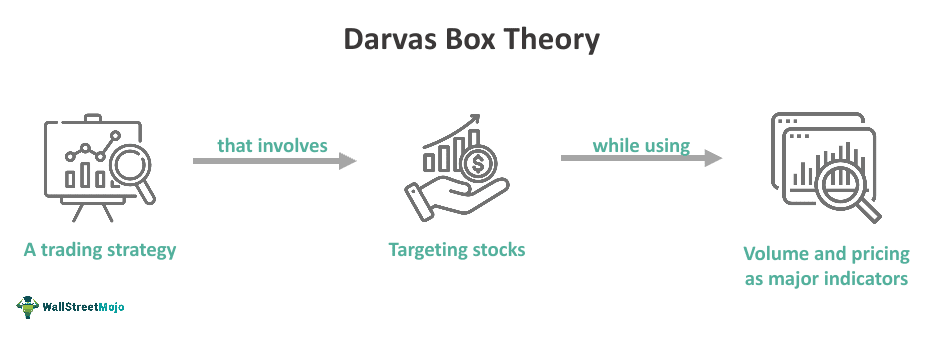Table Of Contents
What Is Darvas Box Theory?
Darvis box theory refers to a trading strategy that Nicolas Darvas developed to target stocks utilizing volume and highs as key indicators. It involves utilizing technical analysis and momentum theory to determine the entry and exit points in the market and generate financial gains.

A stock trades within a Darvas box when its price increases above the previous high before subsequently retracting to a price level relatively near the high. This theory encourages individuals to focus on the industries that can outdo the overall market. It suggests trading the rising boxes only and utilizing the highs of the breached boxes to update stop-loss orders.
Table of contents
- What Is Darvas Box Theory?
- Darvas box theory refers to a trading strategy that individuals or organizations utilize to target stocks while taking into consideration the security’s high trading volume as a vital indicator of price rise.
- Many critics argue that the Nicolas Darvas box theory can work only in a bullish market. Moreover, some experts believe that if traders fail to predict the trend correctly, they might suffer significant losses.
- One has to draw a line along a stock’s recent lows and highs during a given period to construct Darvas boxes.
How Does Darvas Box Theory Work?
The Darvas box theory is a strategy that involves purchasing stocks trading at new highs and constructing a box around the recent lows and highs to determine an entry point as well as an exit point for placing a stop-loss order. It allows traders to target stocks having volume and price as indicators.
This strategy involves following the stocks’ momentum. According to the momentum theory, stock prices that surged previously are likely to rise further in the future. On the flip side, stock prices that fell previously are likely to plunge.
This theory provided traders with insight regarding when they can enter or exit specific positions by preparing boxes around the lows and highs over time. Individuals can construct such boxes if they draw a line across the highs and lows. Individuals can find falling or rising boxes as they update the lows and highs over time.
One must remember that this theory instructs traders to enter long positions in the case of rising boxes and utilize such boxes’ highs to set the exit points. This ensures the trader sells the stock if its price level falls under the exit point. The Darvas box theory appears to be an entirely technical trading strategy that involves using only volume and price details to make trading decisions.
That said, investor Nicolas Darvas used fundamental analysis also to identify the stocks to target. This type of analysis involves observing quantitative and qualitative factors concerning individual investments to make investment decisions. Darvas used to target industries or sectors that provided high excitement potential for consumers and investors and created revolutionary products. He would also look for organizations that maintained strong income growth with time.
Origin
In the 1950s, Nicolas Darvas was traveling worldwide as a ballroom dancer. He acquired The Wall Street Journal and Barron’s subscriptions during that time. That said, he utilized only listed stock prices to identify stocks for investment. That said, he utilized only listed stock prices to identify stocks for investment. Darvas drew boxes and followed trading rules to convert an initial investment worth $10,000 into $2,000,000. Following his success, he wrote a book, which made him extremely popular.
Now, traders utilize this strategy via technical analysis, which involves technical tools that adhere to underlying principles, such as resistance bands, momentum, and support. Darvas applied the strategy when technical charting wasn’t possible, and information flow was much slower. One could apply the same principles used by Darvas with technical charting.
In Practice
As noted above, the Nicolas Darvas box theory encourages traders to concentrate on growth industries. At the time of establishing the system, Darvas chose some stocks from such industries and tracked their trading and prices every day. While tracking the stocks, he used volume as the key indicator to determine whether the financial instrument could make a significant move.
After spotting an unusual trading volume, he prepared a box featuring a narrow stock price range on the basis of the trading sessions’ lows and highs.
Inside that box, the financial instrument’s highs and lows represented the ceiling and floor, respectively. When that security broke through the box’s ceiling, Darvas purchased the stock and utilized the breached box’s ceiling as the position’s stop loss. As more boxes got breached, Nicolas Darvas made additions to that trade and shifted the stop-loss upward. Once the stop-loss was triggered, the trade ended.
How To Trade?
Individuals can follow these steps to trade stocks utilizing this strategy:
Step 1: Look for a stock that records a new yearly or 52-week high.
Step 2: Once the high is set, check that the stock price does not exceed that high for the next three days in a row.
Step 3: The new high of that stock is the box’s, and the breakout point leading to the new high is the box’s low.
Step 4: Purchase the break of that box once it is above the high by some points.
Step 5: Sell the box’s low if breached.
Step 6: Keep adding to the position as the price moves into a new box.
In the TradingView chart of Twitter Inc., many boxes are created using the concept of Darvas Box Theory. The highs and lows point out to the possible exit and entry levels, marked in green and red, respectively. Thus, the trader can successfully use this technical indicator to make trade decisions. After drawing the box, it is easy to identify the breakouts for each box as well as select a proper level for stop loss. The stop losses are set in advance to protect against risk and achieve maximum profitability. They should be typically set at the low of the most recent box, which can also be the high of the previous box because there is a breakout. In this way, as per the chart below, the trader can keep buying the stock in small quantities if a new box is created with a higher high, but the price falls back within the box again.
Example
Let us look at this Darvas box theory example to understand the concept better.
Suppose David is a trader who spotted stock ABC recording a 52-week high of $10. Moreover, he noticed that the financial instrument’s price did not rise above that annual high for the next three consecutive days. He realized the opportunity to utilize the Darvas box theory. The 52-week high became the top of the box, while the lowest price during the next three days became the box’s bottom.
Once the box was complete, he realized that the stock price had closed on top of it. Hence, he purchased 20 shares of ABC and earned a significant profit as the price surged more than 10% over the next two weeks.
Limitations
Various traders utilize the Darvas box theory to execute trades and make financial gains. However, many critics argue that Nicolas Darvas could only convert $10,000 into $2 million because he used the strategy in a bullish market, not a bearish one. They believe that if individuals try to use this strategy in a bearish market, they will incur significant losses.
Moreover, many critics argue that it is impossible to predict all market trends, and if the prediction is incorrect, the use of this strategy can result in losses for traders.
Some more limitations of this theory are as follows:
- It might not be effective in a highly volatile or sideways market, as identifying the boxes can become difficult.
- This strategy comes with the risk of false breakouts. Hence, investors might incur losses.
For professional-grade stock and crypto charts, we recommend TradingView – one of the most trusted platforms among traders.
Disclosure: This article contains affiliate links. If you sign up through these links, we may earn a small commission at no extra cost to you.
Frequently Asked Questions (FAQs)
This theory is not confined to a particular period. Hence, traders or analysts may apply it to charts with different durations.
The potential advantages of this theory are as follows:
- It can be highly effective in a trending market.
- This theory can minimize emotional decision-making in the market. ‘
- It can serve as a very useful tool for spotting high-momentum stocks.
Yes, it can be effective if a trader follows this theory's rules. The risk associated with this strategy is low. That said, traders can suffer losses if the trend prediction is wrong.
One can use relative strength index (RSI), moving averages, and volume indicators with this strategy.
Recommended Articles
This has been a guide to what is Nicolas Darvas Box Theory. Here, we explain its origin, practice, example, limitations, and how to trade it. You can learn more about it from the following articles –

